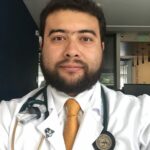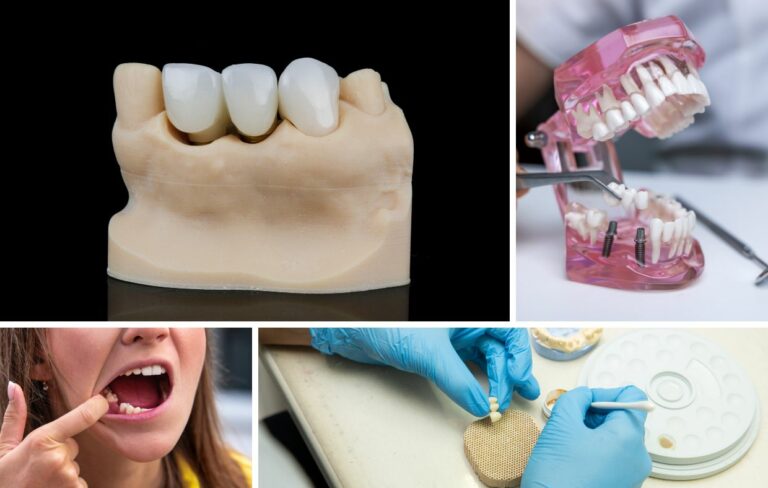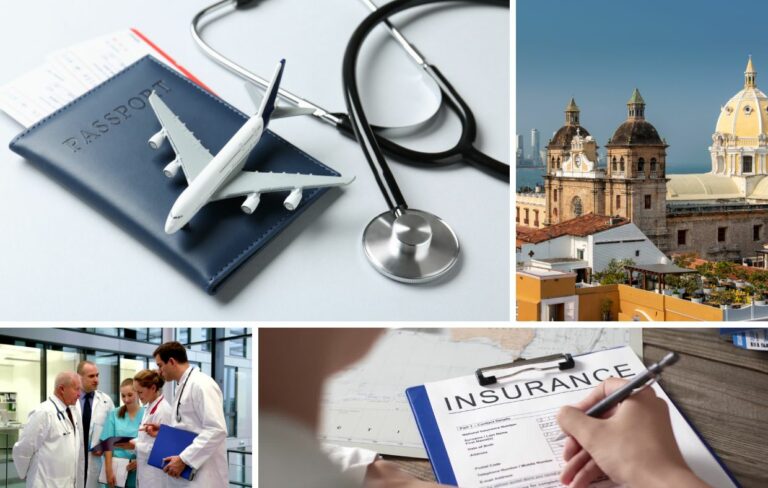Book Appointment Now
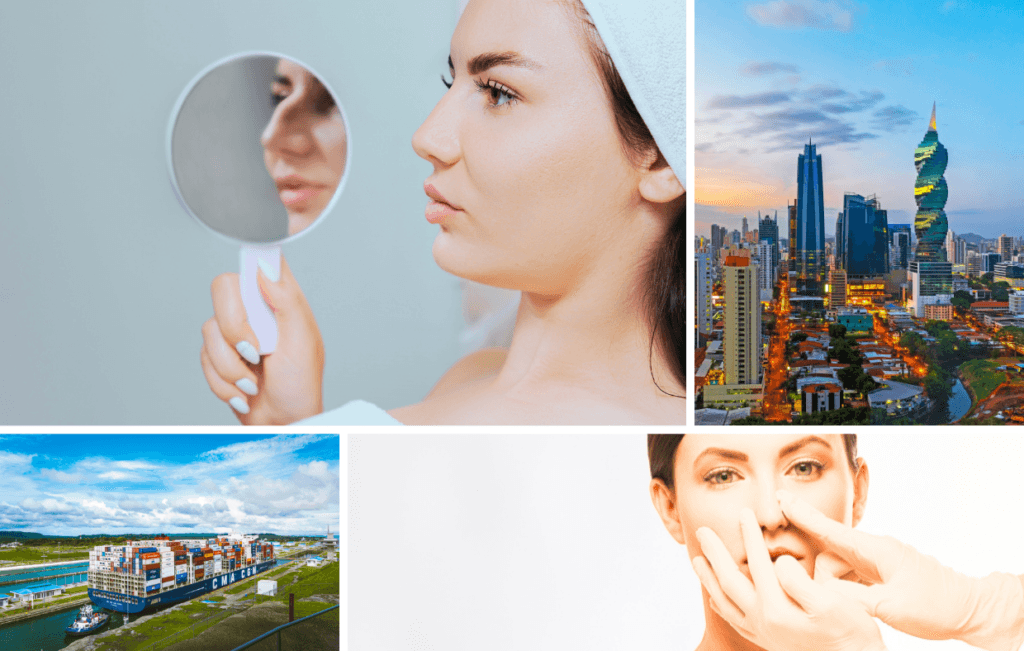
Nose Job and Rhinoplasty Surgery in Panama
Rhinoplasty in Panama combines quality care with lower costs. The country’s medical centers provide nose surgery for appearance and breathing improvements. Board-certified surgeons perform procedures in modern facilities.
Doctors fix birth defects, repair injuries, and enhance facial features. Panama’s medical standards match international requirements. This guide covers costs, surgeons, facilities, procedures, and recovery times for rhinoplasty in Panama.
What is Rhinoplasty Surgery in Panama
Rhinoplasty surgery in Panama modifies nose structure and function. Surgeons correct birth defects, fix injuries, and enhance appearance. The country provides quality medical care at competitive prices. Patients from many countries choose Panama for nose surgery.
Doctors use precise techniques and modern equipment. They adjust nose size, reshape contours, repair bridges, refine tips, and improve airways. Each patient receives an individual treatment plan. Results enhance both appearance and breathing.
Why Choose Panama for Rhinoplasty?
Panama provides key advantages for rhinoplasty patients. Medical costs stay below North American and European prices. Surgeons hold international certifications. Hospitals maintain modern equipment and follow strict protocols.
These benefits help patients receive quality care at reduced costs.
Affordable Costs Compared to North America and Europe
Panama reduces rhinoplasty expenses without reducing quality. Patients access skilled surgeons and modern facilities. The cost difference makes rhinoplasty available to more people.
Access to Skilled and Internationally Trained Surgeons
Panama’s doctors complete training at leading medical institutions. They practice current surgical methods and meet global standards. Their expertise matches international quality benchmarks.
State-of-the-Art Medical Facilities
Medical centers in Panama use current technology and follow safety protocols. The facilities provide advanced care in sterile environments. Patients receive treatment with proven medical equipment.
Types of Rhinoplasty Procedures in Panama
Panama surgeons perform three main rhinoplasty types. Each procedure addresses specific patient needs and goals.
- Cosmetic Rhinoplasty: Enhances nose appearance and facial balance. Surgeons adjust size, shape, and proportions.
- Functional Rhinoplasty: Improves breathing ability. Doctors repair structural problems from birth defects or injuries.
- Revision Rhinoplasty: Fixes results from previous surgeries. Patients receive corrections for prior procedures.
Expert surgeons use proven methods for optimal results in appearance and function.
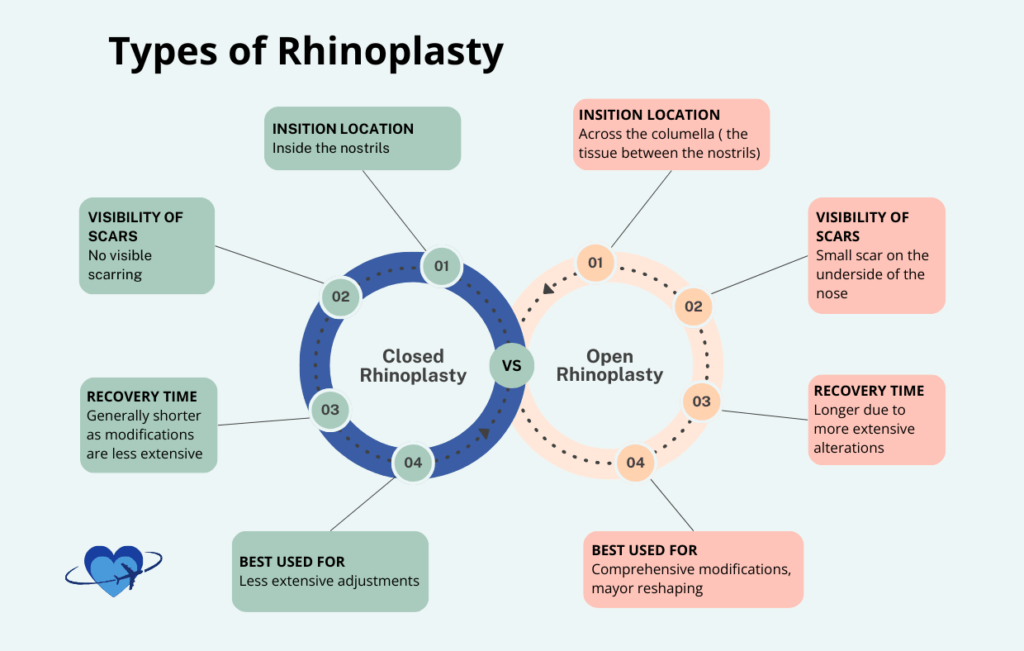
Cosmetic Rhinoplasty: Reshaping the Nose for Aesthetic Purposes
Cosmetic Rhinoplasty creates balanced facial features. Surgeons modify nose dimensions and shape. The procedure enhances natural appearance.
Functional Rhinoplasty: Correcting Nasal Structures to Improve Breathing
Functional Rhinoplasty restores proper airflow. Surgeons repair internal structures and remove blockages. Patients experience better breathing after recovery.
Fixing breathing problems during nose jobs
Lots of people who want cosmetic nose surgery also can’t breathe properly through their nose. The good news? Surgeons can often fix both problems at the same time.
Common breathing issues
Deviated septum – This affects about 80% of people to some degree. When it’s bad enough to block breathing, surgeons can straighten it during your rhinoplasty. They remove the crooked parts while leaving enough structure to support your nose.
Turbinate problems – These finger-like structures inside your nose can get swollen from allergies or just be naturally oversized. Surgeons can trim them down, but it’s a balancing act – remove too much and your nose gets too dry.
Weak nasal valves – This is where the sides of your nose collapse inward when you breathe in. You might notice it gets worse when you exercise. Surgeons can strengthen these areas with small cartilage grafts, usually taken from your septum.
Why do both procedures together?
Insurance often covers the functional parts (fixing breathing) but not the cosmetic changes. Doing everything at once means one recovery period instead of two separate surgeries.
Plus, changing the shape of your nose can actually affect how you breathe. Better to have a surgeon who understands both the functional and cosmetic sides.
Many patients say the breathing improvement is actually more life-changing than the appearance change. Better sleep, less mouth breathing, and no more chronic stuffiness.
Revision Rhinoplasty: Correcting Issues from Previous Surgeries
Revision Rhinoplasty addresses prior surgery complications. Surgeons improve both form and function. The procedure meets patient expectations for appearance and breathing.
How surgeons actually perform your nose job
There are two ways surgeons can get to your nose – through the nostrils or by making a tiny cut underneath. Both work well, but which one you get depends on what needs fixing.
Open technique
The surgeon makes a small cut across the skin between your nostrils. Sounds scary, but it’s only about 4-5mm long. This lets them fold back the skin and see everything inside your nose clearly.
Most patients can’t even see the scar after it heals – one study found 98% of people said their scar was basically invisible after a year. The cut heals in the natural fold of skin, so it blends right in.
Surgeons prefer this method when they need to:
- Fix major shape problems
- Work on the tip of your nose
- Use cartilage from other parts to rebuild areas
- Fix botched jobs from other surgeons
Closed technique
All the cuts stay inside your nostrils, so there’s no external scar at all. The downside? Your surgeon is working pretty much blind, relying on feel and experience to get things right.
This works best for simpler changes like:
- Removing bumps from the bridge
- Minor tip adjustments
- Straightening slightly crooked noses
The surgery usually takes less time, and you’ll have less swelling initially. But if your nose needs major work, most surgeons won’t risk the closed approach.
Recovery Timeline
Research documents specific healing periods after rhinoplasty:
- Patients resume daily tasks in 1-2 days
- Visible swelling reduces after 3 days
- Complete healing requires 2-6 weeks
Medical staff provides recovery guidance and monitors progress.
First week
Days 1-2 are pretty rough. Your nose feels like you have the worst sinus infection of your life. Everything’s blocked, there’s pressure around your eyes, and you’ll probably have some bruising that makes you look like you went a few rounds with a boxer.
The splint comes off around day 5-7. Don’t expect to love what you see immediately – your nose will still be swollen and may look wider than you expected.
Weeks 2-6
This is when you start seeing real improvement. The bruising fades, and you can breathe through your nose again (mostly). About 90% of the swelling goes down in the first 6 weeks.
You can go back to work after about 10 days, though you might still have some residual bruising you’ll want to cover with makeup.
The long haul
Here’s what doctors don’t always tell you upfront – your nose keeps changing for up to two years. The final shape doesn’t really settle until around the 12-18 month mark.
The bones fully heal by about 6 months, but cartilage takes longer to “remember” its new position. This is why some people need minor touch-ups later.
What to expect day-to-day
- You’ll sleep propped up for the first week or two
- No blowing your nose for at least 2 weeks
- Saline rinses become your best friend
- Avoid anything that could bump your nose for 6-8 weeks (including enthusiastic pets and small children)
What’s actually inside your nose
Your nose isn’t just the part you see – there’s a lot going on inside that affects both how you look and how you breathe.
The basic structure
- Nasal bones form the hard upper part you can feel
- Cartilage shapes everything from the middle down to your tip
- The septum is basically a wall made of cartilage and bone that divides your nose into two sides
- Turbinates are like little shelves inside that warm and filter air
Fixing bumps on the bridge
That bump on your nose? It’s usually extra bone, cartilage, or both. Surgeons file down the bone part with special rasps (think really fine sandpaper) and trim cartilage with surgical scissors.
Here’s what many people don’t realize – after removing a big bump, your nose gets wider at the top. Surgeons have to break the nasal bones and push them closer together to prevent that “open roof” look. Sounds brutal, but it heals fine.
Breathing problems surgeons can fix
About 30% of people have a crooked septum that blocks airflow. During rhinoplasty, surgeons can straighten it out – a procedure called septoplasty. They keep about an inch of septum at the top and front for support, but the rest can be repositioned or removed.
Turbinates can also get too big and block breathing. Surgeons can trim these down, but they have to be careful not to remove too much or your nose won’t humidify air properly.
Regulatory Requirements for Surgeons
Panama enforces strict medical practice standards:
- Doctors need 5 years of Panama residency
- All surgeons pass general medicine tests
- Specialists complete additional exams
- Health Department gives final approval
- Certification process takes 12 months
These requirements protect patient safety.
Safety and Infection Rates
Medical studies show procedure safety levels:
- Complications occur in 0.7% of cases
- Infections range from 0-4%
- Risk increases for:
- Secondary operations
- Female patients
- Infection statistics show:
- Initial surgery: 0.19%
- Second surgery: 3.63%
Patient safety depends on surgeon selection and following medical advice.
Selecting a Surgeon in Panama
Successful rhinoplasty requires careful surgeon selection. Patients must verify medical credentials and experience. Reviews and photos demonstrate skill levels. Clear communication ensures proper understanding.
The right surgeon selection improves surgical outcomes.
Verify Credentials and Experience
Medical licenses and experience records matter. Proper verification includes education history and surgical experience. These checks protect patient safety.
Look for Patient Reviews and Photos
Previous patient results show surgical quality. Photos and reviews reveal skill and consistency. This information helps set realistic expectations.
Consider Language and Communication
Direct communication improves surgical results. Surgeons must explain procedures clearly. Translation services help when needed.
Choosing the right surgeon in Panama
What to look for in credentials
Panama requires plastic surgeons to complete a 5-year general surgery residency, then additional specialized training. Many of the best surgeons trained in the US or Europe before returning to practice in Panama.
Look for surgeons who are members of:
- Panamanian Association of Plastic Surgery
- International Society of Aesthetic Plastic Surgery
- American Society of Plastic Surgeons (if they trained in the US)
Red flags to avoid
- Surgeons who won’t show you before/after photos of their own work
- Prices that seem too good to be true (quality rhinoplasty costs money)
- Pressure to decide immediately
- Facilities that aren’t accredited by international organizations
Questions to ask during consultation
- How many rhinoplasties do you perform per month?
- Can I see photos of patients with noses similar to mine?
- What’s your revision rate? (Should be under 5%)
- Where did you train, and how long have you been practicing?
Most established surgeons won’t mind these questions – in fact, they expect them from informed patients.
The consultation should take at least 30 minutes, and the surgeon should examine your nose both externally and internally. If they’re rushing you through or seem more interested in booking surgery than understanding your goals, keep looking.
Average Cost of Rhinoplasty in Panama
Panama provides rhinoplasty at lower costs. Quality remains high with modern facilities and skilled surgeons.
Costs vary by procedure complexity and patient needs.
Significantly Lower than in the US, Canada, and Europe
Cost differences make Panama attractive for rhinoplasty. Quality care becomes accessible to more patients.
| Country/Region | Average Cost of Rhinoplasty (USD) |
|---|---|
| United States | $7,000 – $15,000 (up to $45,000 at high-end clinics) |
| Canada | $9,500 – $20,000 |
| UK | $5,000 – $10,000 |
| Spain | Average around $4,749 |
| Panama | Starting from $2,100 (2015 data) |
Final costs reflect surgeon expertise and procedure requirements.
Medical Facilities in Panama
Panama features top medical centers:
- Pacífica Salud Hospital Punta Pacífica – #7 in Latin America, Johns Hopkins partner
- Hospital Paitilla – Cleveland Clinic partner
- Clinica Hospital San Fernando – JCI certified
These centers meet international medical standards.
Preparing for Surgery in Panama
Preparing for surgery in Panama involves several key steps to ensure a smooth and successful experience. Patients should undergo necessary pre-operative medical tests to assess their suitability for rhinoplasty and to identify any potential issues that could affect the surgery or recovery. It’s also important to arrange accommodation and transportation in advance, considering the proximity to the medical facility and the comfort needed during recovery.
Understanding the post-operative care plan is crucial; this includes knowing the follow-up schedule, medication management, and any specific care instructions to aid in a smooth recovery. Taking these steps helps patients feel more prepared and confident as they approach their surgical procedure.
Necessary Pre-operative Medical Tests
Patients preparing for rhinoplasty in Panama typically need to undergo a series of pre-operative medical tests, which may include:
- Blood tests: To check for any conditions that could complicate surgery or anesthesia.
- Physical examination: To ensure overall health stability.
- Nasal imaging: Such as X-rays or MRIs, to assess the nasal structure and plan the surgery.
Arranging Accommodation and Transportation
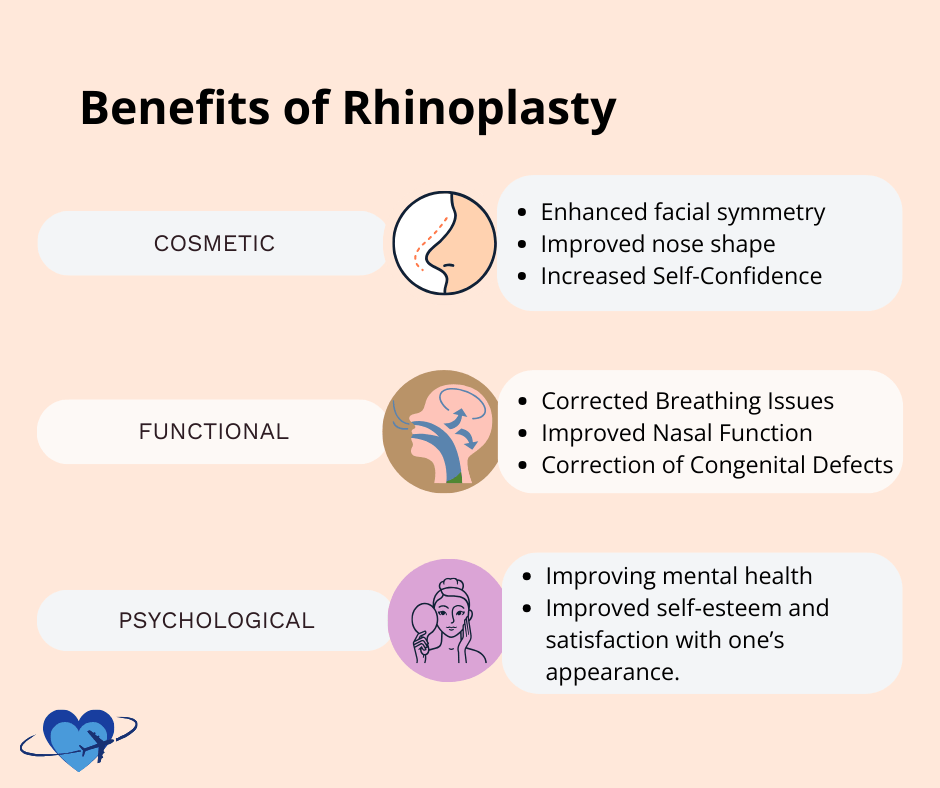
When planning your stay in Panama for rhinoplasty, consider:
- Accommodation: Look for hotels or apartments close to the clinic for convenience. Many medical facilities can recommend nearby places that cater to medical tourists.
- Transportation: Plan for how you will travel to and from the clinic and airport. Some accommodations and clinics offer shuttle services for medical patients.
Understanding the Post-operative Care Plan
A detailed post-operative care plan is essential for recovery. This plan often includes:
- Follow-up visits schedule: Knowing when your check-ups are will help monitor your healing process.
- Medication management: Understanding any antibiotics, pain relief, or anti-inflammatory medications you may need.
- Care instructions: Specific guidelines on how to care for your surgical site, activities to avoid, and tips for reducing swelling and discomfort.
By thoroughly preparing for your rhinoplasty in Panama, including understanding the necessary pre-operative tests, arranging suitable accommodation and transportation, and familiarizing yourself with the post-operative care plan, you can help ensure a more comfortable and stress-free surgical experience.
Legal and Ethical Considerations
When undergoing rhinoplasty in Panama, it’s essential to be aware of the legal and ethical considerations involved. Ensuring that the chosen clinic and surgeon are fully certified and adhere to Panama’s medical laws and standards is crucial for patient safety and the success of the procedure. Patients should also understand the insurance and liability issues that might affect their care.
| Consideration | Description | Why It’s Important |
|---|---|---|
| Ensuring the Clinic and Surgeon are Certified | Verify that the clinic and surgeon have the necessary certifications from recognized medical boards and institutions. | Confirms adherence to high standards of safety and quality, reducing the risk of complications. |
| Understanding Panama’s Medical Laws and Standards | Familiarize yourself with the legal framework governing medical practice and patient rights in Panama. | Ensures informed decision-making and helps protect your rights as a patient. |
| Considering Insurance and Liability Issues | Investigate how your medical insurance applies overseas and understand the liability policies of the clinic and surgeon. | Clarifies financial responsibilities and coverage in case of complications, ensuring you are prepared for any situation. |
Ensuring the Clinic and Surgeon are Certified
It is crucial to ensure that both the clinic and the surgeon in Panama hold the proper certifications. This verification step confirms their adherence to the highest standards for providing safe and effective rhinoplasty procedures.
Understanding Panama’s Medical Laws and Standards
Patients should make an effort to thoroughly understand Panama’s medical laws and standards. This understanding is vital for making informed decisions about their surgery and for ensuring that their rights are fully protected throughout the surgical experience.
Considering Insurance and Liability Issues
Considering insurance and liability issues is a critical aspect of planning for rhinoplasty in Panama. Patients need to be clear on how these factors might affect their care, including coverage details and their own responsibilities, should there be any unforeseen complications.
How nose jobs affect your confidence
The psychology of nose jobs
Your nose sits right in the center of your face, so when you don’t like it, you really don’t like it. A lot of patients say they’ve been self-conscious about their nose since they were teenagers.
One study found that 87% of rhinoplasty patients reported improved self-confidence six months after surgery. But here’s the thing – the physical change isn’t always dramatic. Sometimes it’s more about finally feeling like your outside matches how you see yourself inside.
What patients actually say
“I stopped covering my face in photos” is something surgeons hear a lot. Or “I don’t automatically turn to my good side anymore.” Small changes, but they matter.
The psychological impact seems biggest for people who’ve been teased about their nose or who’ve avoided certain activities (like swimming) because they didn’t want people to see their profile.
Managing expectations
Not everyone’s a good candidate psychologically. If you’re expecting a nose job to completely change your life or fix relationship problems, most good surgeons will suggest waiting.
The best results happen when people have realistic expectations about what surgery can and can’t do. Your nose will look better, but you’ll still be you.
Long-term satisfaction
Follow-up studies show most people (around 95%) are happy they had the surgery, even years later. The main regret? Waiting so long to do it.
Risks of Rhinoplasty Surgery
Like all surgical procedures, rhinoplasty carries certain risks. Patients may face a risk of infection, which is a concern with any surgery. There’s also the potential for breathing difficulties if the nasal structure is significantly altered.
Additionally, there exists the possibility of dissatisfaction with the aesthetic outcomes, necessitating further corrective procedures. It’s important for patients to discuss these risks thoroughly with their surgeon to have a clear understanding of the potential complications and how they are managed.
- Risk of Infection: There is a risk of infection following rhinoplasty, as with any surgical procedure. This risk underscores the importance of choosing a reputable surgical facility and adhering to post-operative care instructions to minimize complications. The incidence of infection post-rhinoplasty is relatively low, with reputable clinics reporting rates below 2%. Effective management includes antibiotics and strict sterile techniques during surgery.
- Potential for Breathing Difficulties: Rhinoplasty can lead to breathing difficulties, especially if significant structural changes are made to the nasal passages. It’s crucial for patients to discuss potential impacts on nasal function with their surgeon prior to the procedure to ensure a comprehensive understanding of the risks involved. Surgeons can mitigate this risk by carefully planning the surgery to maintain or enhance the structural integrity of the nasal airways.
- Possibility of Dissatisfaction with Aesthetic Outcomes: There exists the possibility of dissatisfaction with the final aesthetic results, highlighting the need for realistic expectations and clear communication with the surgeon about desired outcomes. This dialogue is essential for aligning patient expectations with achievable results. Studies suggest that the dissatisfaction rate can be reduced significantly with thorough pre-surgical consultations and realistic 3D imaging to set achievable goals.
Medical Tourism Packages for Rhinoplasty
Transform your rhinoplasty journey into a comfortable and worry-free experience with our comprehensive medical tourism packages. We handle every detail of your medical travel to Panama, from your initial consultation to your final recovery day. Our all-inclusive packages cover private consultations with top surgeons, all hospital and surgical fees, medications, and post-operative care. We enhance your experience with premium services including airport pickup in a private car, stays at four-star hotels near your medical facility, and dedicated local transportation. A personal medical coordinator remains available throughout your stay, providing support and translation services whenever needed.
Start your transformation by contacting our coordinators 3-4 months before your desired surgery date. Our structured approach makes planning simple—we arrange your video consultation with a chosen surgeon, help select optimal travel dates, and manage all appointments and logistics. By combining medical care with travel services, you save significantly on total costs through our partnerships with leading hospitals and hotels. Your package includes all necessary medical care, comfortable accommodation, and support services, with no hidden fees. Contact our coordinators today to begin your journey to a more confident you.
Frequently Asked Questions
What is rhinoplasty surgery in Panama?
Rhinoplasty surgery in Panama modifies the structure and function of the nose. Surgeons correct birth defects, repair injuries, and enhance appearance. The country offers high-quality medical care at competitive prices, making it a popular choice for international patients.
Why choose Panama for rhinoplasty?
Panama offers high-quality rhinoplasty at a lower cost than North America and Europe. The country has internationally trained surgeons, modern medical facilities, and strict safety protocols, ensuring excellent surgical outcomes.
What types of rhinoplasty procedures are available in Panama?
Panama offers three main rhinoplasty types: Cosmetic Rhinoplasty for appearance enhancement, Functional Rhinoplasty to improve breathing, and Revision Rhinoplasty to correct previous procedures. Each is tailored to patient needs.
What is the average cost of rhinoplasty in Panama?
The cost of rhinoplasty in Panama starts at approximately $2,100, significantly lower than in the US, Canada, and Europe. Prices vary depending on the complexity of the procedure and the surgeon’s expertise.
